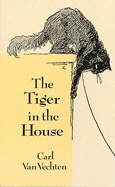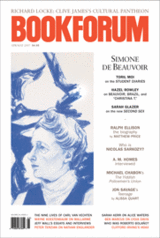

Loyalty, blind obedience, and a keen sense of smell, though dull attributes in a human being, are considered sterling in a dog—a fact that might explain why the inscrutable cat alone inherits such a history of symbol and suspicion. A deity in pharaonic Egypt, in ancient Rome the incarnation of liberty, and in medieval Europe a diabolic familiar consigned with all sorcery to the flames, the cat has embodied intensities of good and evil to an extent that no born dog lover could ever claim for the canine. But of course, dog lovers are not born, they develop—their yearning for companionship assuaged over time by the wagging tail, panting shadow, and poignant enthusiasm for retrieval. Cats curry no favor and woo no skeptics: Their partisans are lifelong and unquestioning, the heirs to an affinity beyond explanation or apology.
Thus the theory—and if Carl Van Vechten questioned it, he knew better than to say so in The Tiger in the House: A Cultural History of the Cat, the lighthearted compendium of feline lore he published in 1920 and complemented in 1921 with Lords of the Housetops: Thirteen Cat Tales, his selection of feline fiction (The Tiger in the House has just been reissued by New York Review Books). But Van Vechten was never agnostic where cats were concerned, and his decision to codify their incarnations in law, folklore, the occult, and the arts, to rehearse the legends of their famous devotees and to recount without flinching the atrocities of their persecutors, was undertaken not for money but for love. It was a love declared before it could be spoken: When still a baby and reckless of the world beyond Cedar Rapids, Iowa, he devoted such freedom as he had to his grandmother's ancient tortoiseshell, who endured uncomplainingly the contrary caresses of her coat, learning as we all must that the torments of the lover are as nothing to the torments of the beloved. As a boy, he flirted with mice, turtles, canaries, chameleons, an alligator, and even a dog—but he was a born city dweller and destined as such for feline companionship: For among the domesticated animals, only the cat can inhabit cities without longing atavistically for the primal savannah, its ancient instincts for territorialism and predation satisfied in verminous alleys and serried metropolitan gardens.
[[img]]
Van Vechten embraced his urban destiny by way of the University of Chicago and for two years after graduation worked as a journalist in the city, as often as not reporting on society events until his mockery of the local plutocracy led to dismissal. He could have lingered, like many another prairie poet and romancer, to join Chicago's impending literary florescence, but he knew without seeing them that New York's lights blazed more brightly, and in 1906, he migrated, seldom to visit the Midwest again except in the reconstructions of fiction and memoir. He was twenty-six when he became a New Yorker, and the love affair that ensued, eclipsing in duration and perhaps intensity all later attachments, was possibly the most formative of his life. For the first twenty-odd years of his metropolitan career, however, cats—whether anonymous street stalkers or his own beloved Ariel, Feathers, and Scheherazade—were a rival claimant on his affections, their eccentricities catalogued with a fond precision rarely accorded the human beings permitted his proximity. Van Vechten stopped owning cats in his forties, not because he tired of them but because he could no longer bear the pain of losing them. By then, however, The Tiger in the House had established him as their apologist, and the trope was developing, as his career pursued its various reinventions, that he, too, had nine proverbial lives.
These reinventions lay ahead when he inaugurated his New York career with an article heralding the American premiere in 1907 of Richard Strauss's opera Salome. In the event, Van Vechten was ahead of his time and ahead of New York—a proleptic posture that was to characterize much of his criticism—since Salome was revoked as a moral outrage after only one performance. Undismayed, he became a music critic for the New York Times, his acceptance of the new dissonances never compromising his enthusiasm for traditional opera, and then America's first dance critic, his responsiveness to the fugitive poetry of performance yielding unrivaled accounts of Pavlova, Nijinsky, and Isadora Duncan. Straying from the Times and digressing from music, and in a colloquially elegant style complementary to his cosmopolitanism of range, Van Vechten was to champion many obscure artists and foretell much future greatness in the years ahead. But whether he was resurrecting Herman Melville in the Double Dealer or introducing George Gershwin in Vanity Fair; whether he was describing the excesses of contemporary Hollywood or vindicating the all-American originality of jazz; or whether, above all, he was sponsoring the achievements of the Harlem Renaissance, he was reinforcing the broader argument that lends his criticism its prophecy and importance: Vigorous, various, and popular, American self-expression could not and would not conform to the imported and outdated pieties of the Gilded Age.
While still evolving as a critic, Van Vechten took to fiction and dominated best-seller lists of the 1920s with a series of comic novels about metropolitan America. Then he turned photographer, and between 1932 and his death in 1964, he photographed almost everyone of importance in the arts of the English-speaking world. Then he joined the war effort, marshaling Broadway and Hollywood to entertain Allied troops at the Stage Door Canteen. And then he became an archivist, donating his immense correspondence with black American artists to Yale University and founding lesser archives elsewhere that mirror the cultural life of New York in its artistic golden age and his participation as catalyst and commentator. And all the while—as host and as guest—he attended hundreds of parties, his constant need for stimulus dictating involvement with a famous and flamboyant circle. But what the convivial cocktail crowd never knew, as he moved among them with white hair and walrus teeth, his shirts and ties provocatively contradictive, was the extent to which this apparently gregarious man, whose very trade was advocacy and espousal, guarded a personal reticence, his fears and longings clandestine, his generosity and love a fickle and elusive privilege.
The secret, as his enduring intimates discovered, lay not in claiming that privilege but in awaiting its bestowal. To claim was to need, and Van Vechten feared dependency; hence the charm of cats, who understand an owner's need for privacy. Children were obviously out of the question, and friends who threatened to become dependents, especially by asking for money, risked absolute severance. Wives may have thought they had greater entitlement, but Van Vechten's first marriage ended almost certainly because his wife demanded monogamy rather than coexistence with male lovers. His second wife tolerated the boyfriends—who were taken about with an openness that looks either cruel or courageous—and that marriage endured for fifty tempestuous years, but when not the victim of nervous illnesses, she often displaced herself abroad to allow her husband his privacy. The boyfriends themselves—some volatile and self-destructive, like playwright Avery Hopwood; otherwise, tractable men who came and went politely—often managed the transition from lover to friend, but even in their heyday they, too, could be dropped for unwitting transgressions or betrayed for a cheap black gigolo.
The Homoerotic Photography of Carl Van Vechten: Public Face, Private Thoughts confirms the erotic curiosity inherent in Van Vechten's Harlem sponsorship and the voyeurism—obverse to the spectatorship of his criticism—that informed so much of his life. The book's sequence of nudes, mostly of black model Allan Meadows and white ballet dancer Hugh Laing, also testifies to this artist's controlling nature: Isherwood, in Goodbye to Berlin, deployed a camera "quite passive, recording, not thinking," but Van Vechten's was the apparatus of a tireless regulator, and the amateur quality of these pictures should not suggest spontaneity of execution or randomness of content. Nor should their nudity automatically imply eroticism. To be sure, these camp and theatrical tableaux are more than anatomical documentation, but the fantasies, if any, that they gratified are of an esoteric order.
With its poor reproductions and cramped text, James Smalls's book looks at first like a specimen of cheap publishing, and it takes a momentary comparison of title and illustrations to confirm that it is also an exercise in irresponsible authorship. These are not the "homoerotic" photographs, but a selection from which Van Vechten's white male nudes have been excluded in support of preconceived theories—theories embedded somewhere in a turgid and jargon-ridden text that nobody beyond the densest thickets of academe will understand. Where the text is comprehensible, it misleads: Smalls errs repeatedly about Van Vechten's life and the world in which he moved. The book's aims are unfathomable; more mysterious still, the author himself, an associate professor of art history who misspells Nella Larsen and Mabel Dodge and thinks Cecil Beaton was American. How did someone so cavalier secure the guidance of impressionable undergraduate minds?
Clive Fisher is the author of biographies of Hart Crane and Cyril Connolly. He is at work on a biographical study of Carl Van Vechten.

